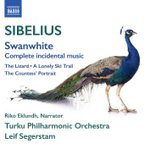|
Back
11/18/2015
Jean Sibelius: Svanevit, JS189 – Ödlan, Opus 8 – Ett ensamt skidspår, JS77b – Grevinnans konterfej, JS88
Riko Eklundh (Narrator), Turku Philharmonic Orchestra, Leif Segerstam (Conductor)
Recording: Turku Concert Hall, Turku, Finland (January 24, February 5-6, and September 10, 2014) – 63’34
Naxos # 8.573341 – Booklet in English – Narration transcriptions in Finnish and English

   
Jean Sibelius’ lengthy life paved way for a myriad avenue of influences. Life, love and public reaction would play roles, some of the predominating forces extolling the Finnish composer’s musical interpretations. Sibelius’ expansive œuvres also reached into that of incidental music with flits of melodramatic pieces set to narration. This esoteric collection is intriguingly weighty and pensive.
Dominating Naxos’ CD, Swanwhite signifies ‘musical symbolism’, a reflective response after Sibelius’ creation of music set to Maeterlinck’s play Pelléas et Mélisande. Sibelius employs the eponymous heroine’s mother’s and father’s presence through a breviloquent horn (father) or one long crescendo chord (Swan-mother.) Swanwhite, based on August Strindberg’s 1901 fairy-tale, is a loose mesh of Cinderella and The Sleeping Beauty, filled with emphasis on strings’ pizzicato arpeggio in several sections. The scoring closely resembles Prokofiev’s Romeo and Juliet to denote the Swan-mother’s disapproval of her unkempt daughter as a result of an evil Stepmother.
Leif Segerstam succinctly focuses on specific instruments to heighten the unfolding emotions, particularly with light timpani and musky clarinet to express the protagonists’ anxiety. Grieg influences surface during the Swan-mother’s submissive attention to washing her daughter’s feet. Though sections are occasionally dreamy, the ill-fated wedding waltz (Young King and Swanwhite) is deeply melancholic, conjuring “Ase’s Death” from Peer Gynt, while the blissful post-nuptial goings-on between The Prince and Swanwhite factor Eurasian reminders of Rimsky-Korsakov’s Schehrezade.
Vaughan Williams’ grand, extant strings filter into the equation during the episodic drowned Prince, but revival and happiness return in the end by use of Turku Philharmonic Orchestra’s organ regalia without demonstrative exorbitance. An aside, Swanwhite might make for an interesting ballet.
Good and evil dwell inside the incidental music for The Lizard (Ödlan) that’s based on a 1910 play written by Mikael Lybeck. Seldom-heard, the two-scene composition has a weighty second movement (“Grave.”) Sibelius used crescendos (while pulling back with lighter degrees of decrescendos) to intensify the murky doings of the squamate reptile-dressed Adla. Ominous yet riveting, there is a keen attention on fear and passion. The clouds briefly part with optimistic chords, but it doesn’t last long. One can likely see why this piece isn’t in active repertoire.
Unquestionably, Jean Sibelius loved the outdoors and nature. The forests surrounding his home in Ainola, Finland would be the suitable vehicle for Riko Eklundh to emphasize the earthy landscaping in Sibelius’ A Lonely Ski Trail. Mr. Eklundh’s vocalization never over-dramatizes, yet it is measured and intent. Reminiscent of a Robert Frost poem, the ending, which focuses on the abrupt end of the trail and cerebral inconclusiveness, brings harp to the forefront to portray the slowly falling snowflakes. Quite fitting.
If A Lonely Ski Trail trended on life’s end (Winter), then a sparing contrast could be found in The Countess’ Portrait, epitomizing an awakening of life with vestiges of eternal youth (Spring.) Though thoughtfully reserved, Sibelius’ music is not befitting for the text by Zachris Topelius: it has more irony with its signatures of solemnity and somberness.
Christie Grimstad
|